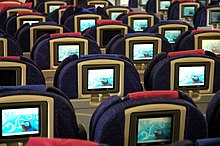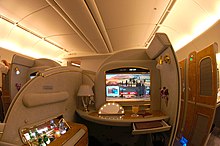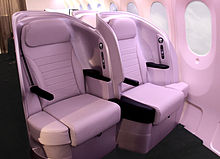American Airlines is a major US-based airline headquartered in Fort Worth, Texas, within the Dallas–Fort Worth metroplex. It is the largest airline in the world when measured by scheduled passengers carried and revenue passenger mile. American, together with its regional partners and affiliates, operates an extensive international and domestic network with almost 6,800 flights per day to nearly 350 destinations in 48 countries. American Airlines is a founding member of the Northeast Alliance, and also a member of the Oneworld alliance. Regional service is operated by independent and subsidiary carriers under the brand name American Eagle.

KLM Royal Dutch Airlines, legally Koninklijke Luchtvaart Maatschappij N.V., is the flag carrier of the Netherlands. KLM is headquartered in Amstelveen, with its hub at nearby Amsterdam Airport Schiphol. It is a subsidiary of the Air France–KLM group and a member of the SkyTeam airline alliance. Founded in 1919, KLM is the oldest operating airline in the world, and has 35,488 employees with a fleet of 110 as of 2021. KLM operates scheduled passenger and cargo services to 145 destinations.
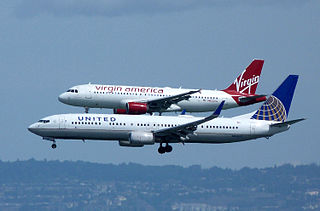
An airliner is a type of aircraft for transporting passengers and air cargo. Such aircraft are most often operated by airlines. Although the definition of an airliner can vary from country to country, an airliner is typically defined as an airplane intended for carrying multiple passengers or cargo in commercial service. The largest of them are wide-body jets which are also called twin-aisle because they generally have two separate aisles running from the front to the back of the passenger cabin. These are usually used for long-haul flights between airline hubs and major cities. A smaller, more common class of airliners is the narrow-body or single-aisle. These are generally used for short to medium-distance flights with fewer passengers than their wide-body counterparts.

Emirates is one of two flag carriers of the United Arab Emirates. Based in Garhoud, Dubai, the airline is a subsidiary of The Emirates Group, which is owned by the government of Dubai's Investment Corporation of Dubai. As of 2019, it was also the largest airline in the Middle East, operating over 3,600 flights per week from its hub at Terminal 3 of Dubai International Airport. It operates to more than 150 cities in 80 countries across all continents through its fleet of nearly 300 aircraft. Cargo activities are undertaken by Emirates SkyCargo.
Air Canada is the flag carrier and the largest airline of Canada by size and passengers carried. Air Canada maintains its headquarters in the borough of Saint-Laurent, Montreal, Quebec. The airline, founded in 1937, provides scheduled and charter air transport for passengers and cargo to 222 destinations worldwide. It is a founding member of the Star Alliance. Air Canada's major hubs are at Toronto Pearson International Airport (YYZ), Vancouver International Airport (YVR), and Montréal–Trudeau International Airport (YUL). The airline's regional service is Air Canada Express.

Singapore Airlines is the flag carrier of the Republic of Singapore with its hub located at the Singapore Changi Airport. The airline is notable for highlighting the Singapore Girl as its central figure in the corporate branding segment. The airline has been ranked as a 5-star airline by Skytrax since the 1990s, and it has also been ranked as the world's best airline five times.

A wide-body aircraft, also known as a twin-aisle aircraft, is an airliner with a fuselage wide enough to accommodate two passenger aisles with seven or more seats abreast. The typical fuselage diameter is 5 to 6 m. In the typical wide-body economy cabin, passengers are seated seven to ten abreast, allowing a total capacity of 200 to 850 passengers. The largest wide-body aircraft are over 6 m (20 ft) wide, and can accommodate up to eleven passengers abreast in high-density configurations.

Air China Limited is the flag carrier of the People's Republic of China and one of the "Big Three" mainland Chinese airlines. Air China's headquarters are in Shunyi District, Beijing. Air China's flight operations are based primarily at Beijing Capital International Airport. In 2017, the airline carried 102 million domestic and international passengers with an average load factor of 81%. The airline joined Star Alliance in 2007.
EVA Airways Corporation, of which "EVA" stands for Evergreen Airways, is one of the two largest airlines in Taiwan – the other being China Airlines. It operates passenger and dedicated cargo services to over 40 international destinations in Asia, Australia, Europe, and North America. In contrast to the state-owned flag carrier China Airlines, EVA Air is privately owned and flies a fully international route network with no domestic destinations. It is rated as a 5-star airline by Skytrax, and is the second largest airline based in Taiwan after China Airlines. EVA Air is headquartered at Taoyuan International Airport in Luzhu, Taoyuan City. The company slogan is "Sharing the World, Flying Together".
Transaero, officially OJSC Transaero Airlines was a Russian airline that operated scheduled and charter flights to over 150 domestic and international destinations. Transaero's main hubs were Moscow Vnukovo Airport and Saint Petersburg Airport with further bases throughout Russia. For much of its history the head office was at Domodedovo International Airport, and towards the end its head office was in Saint Petersburg.
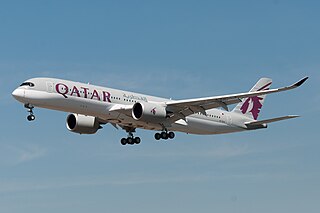
The Airbus A350 is a long-range, wide-body twin-engine jet airliner developed and produced by Airbus. The first A350 design proposed by Airbus in 2004, in response to the Boeing 787 Dreamliner, would have been a development of the Airbus A330 with composite wings and new engines. As market support was inadequate, in 2006, Airbus switched to a clean-sheet "XWB" design, powered by two Rolls-Royce Trent XWB turbofan engines. The prototype first flew on 14 June 2013 from Toulouse, France. Type certification from the European Aviation Safety Agency (EASA) was obtained in September 2014, followed by certification from the Federal Aviation Administration (FAA) two months later.
Singapore Airlines operates a predominantly widebody fleet, until the second re-introduction of the Boeing 737 in March 2021 following the merger with SilkAir. The airline also operates Boeing 747-400F and Boeing 777F freighters. As of May 2023, there were 157 aircraft registered in the Singapore Airlines fleet, comprising 148 passenger aircraft and 9 freighters.

Business class is a travel class available on many commercial airlines and rail lines, known by brand names which vary, by airline or rail company. In the airline industry, it was originally intended as an intermediate level of service between economy class and first class, but many airlines now offer business class as the highest level of service, having eliminated first-class seating. Business class is distinguished from other travel classes by the quality of seating, food, drinks, ground service and other amenities. In commercial aviation, full business class is usually denoted 'J' or 'C' with schedule flexibility, but can be many other letters depending on circumstances.
Economy class, also called third class, coach class, steerage, or to distinguish it from the slightly more expensive premium economy class, standard economy class or budget economy class, is the lowest travel class of seating in air travel, rail travel, and sometimes ferry or maritime travel. Historically, this travel class has been called tourist class or third class on ocean liners.

An airline seat is a seat on an airliner in which passengers are accommodated for the duration of the journey. Such seats are usually arranged in rows running across the airplane's fuselage. A diagram of such seats in an aircraft is called an aircraft seat map.

Premium economy class, also known by brand names which vary by company, is a travel class offered on many airlines. It is usually positioned between standard economy class and business class in terms of price, comfort, and available amenities. In 1991, EVA Air was the first to introduce Evergreen Class, becoming the first airline to offer this class of service. It was widely acknowledged that the premium economy class has become a standard reflection of what the economy class was like several decades ago. In some countries, this class has emerged as a response from governments and companies requiring economy class for travel done by staff.

Scoot Pte Ltd, operating as Scoot, is a Singaporean low-cost airline and a wholly owned subsidiary of Singapore Airlines. It began its operations on 4 June 2012 on medium and long-haul routes from Singapore, predominantly to various airports throughout the Asia-Pacific region. Scoot's airline slogan is Escape the Ordinary.
PT Batik Air Indonesia, operating as Batik Air, is an Indonesian scheduled airline based at Soekarno Hatta International Airport in Jakarta, Indonesia. The airline was founded in 2012 as the full-service arm of the Lion Air Group and made its maiden flight on 3 May 2013 from Jakarta to Manado and Yogyakarta. The airline is certified as a 3-Star Airline by Skytrax.

First class is a travel class on some passenger airliners intended to be more luxurious than business class, premium economy, and economy class. Originally all planes offered only one class of service, with a second class appearing first in 1955 when TWA introduced two different types of service on its Super Constellations.
The Air New Zealand fleet consists of Boeing jet aircraft for long-haul flights, and Airbus jet aircraft for domestic and short-haul international flights. The airline also operates ATR 72 and Bombardier Q300 turboprop aircraft on domestic services.

